By Sea Kayak to St Kilda, Solo
Trip Report by Giles Trussell, Glenmore Lodge Instructor
Solo. Commitment – a long term marriage.
I was reflecting on where it all began. Probably on a school trip to Loch Hourn. The day I paddled away over a kilometre ahead of the group. There was a gusty wind from my right and a classic ‘school boy (because that’s what I was) error’ led me to capsize – the wind catching my, out of the water, right hand vertical blade. I was in stand-up shallow water and by the time the teacher reached me I was all sorted and back in my kayak, if not a little chastened. That night I bivied outside my tent until the early morning, when weird sounds I couldn’t fathom or locate drove me under canvas. It was, as I later learned a snipe drumming. That was all in early June 1983.
It was around about that time I did my first roll on the sea. My Mum and Dad had bought some second-hand kayaks, paddles, spray decks and yellow lifejackets (the over the neck variety that really were life jackets and not the PFD’s of today) from the Garelochhead – where we lived – Outdoor Centre. I still remember the kayak, a Pyranha SS Elite. I had been taught in a pool at school and choosing my moment, unknown to anyone I rolled in the Gareloch, solo.
Fast forward a few years to 1990. I’m working for Raasay Outdoor Centre. My paddling has fairly come on and I make regular sea kayak crossings to Sconser on Skye. My island escape. My time away from work and into the hills. It was while working there I did a one-day circumnavigation of Raasay, solo.
My location changed to Benmore Outdoor Centre on the Cowal peninsular. There was a great ethos among the staff of getting out and doing stuff. And I did too. With access to Nordkapps and Anas Acuta my sea kayaking experiences grew. Mostly with groups of friends. The solo ventures began though – Kerrera, Gigha with a crossing in the dark, Loch Hourn on a Munro mission when I bivied on Ben Sgritheall and watched a thunderstorm illuminate the Skye Cuillin, Lismore, Loch Nevis, numerous visits to Inverie in Knoydart where my folks moved, including one in a South Westerly Force 8. The sea kayak was a handy ‘ferry’ – I was dependent on no-one to get there.
The forays continued and my experience grew. I had many great trips with friends. Arran, Islay, Garvellachs, Soay, Canna, Rum, Cape Wrath, Shetland, the Moray coastline, the coastline from Berriedale to Wick. Another Raasay and Rona trip with my wife, Handa numerous times including through the Great Stack. An Irish sea crossing both ways. Shiants from Skye and on to Tarbet on Harris on a mercury sea. Work too took me to some great spots, guiding and instructing groups all around the Scottish Coastline. Expeditions to Greenland, the Mediterranean – Ithaca and Kefalonia and a stupendous circumnavigation of Stewart Island in New Zealand with Carl Haberl. The conditions experienced on that circumnavigation were a massive psychological challenge and there, commitment was the overriding sensation.
I was lucky to have all this constantly interrupted by my main paddling passion at the time which was rivers. Year-round in Scotland, European Alps, Nepal, India, Ecuador and even Kyrgyzstan. The skill set gained on the rivers could be taken to any environment the sea chose to throw at me; the only stoppers in the frame would always be tidal streams – if they were in the wrong direction and strong – and of course wind.
Life’s journey continued, marriage, children, a full-time job and mortgage. I cannot remember exactly when I decided to do this but I found time out was needed. Only once a year. My week, just me. How I now look forward to that. Total recharge. It has always involved solo sea kayaking in Scotland, mostly incommunicado – the longest without speaking to someone was 4 days. Not that I avoid people, as I have had very many interesting interactions with the people I meet along the way.
My time. Alone to make my own decisions – where to go and what to do; when to eat, and what to eat; what to drink; when to wake and when to sleep; when to stop and when to start. I’ve enjoyed 8 big solo trips and they’ve all been memorable.
2011 began the process in earnest with two visits, a year apart that led to circumnavigating Harris and then Lewis. Harris memorable for 24 hours of solid rain and getting storm bound on Taransay. Lewis on the first visit gave a unique 6km portage at one stage to link-up Loch Shiophoirt (Seaforth) with Loch Eireasort.
2012 followed the Eastern seaboards of North Uist, Benbecula and South Uist with a sleety start at sea level (a week later West Scotland was basking in 26 degree heat) a night at the newly refurbished Uishnish Bothy and included summiting Eabhal one day and Hecla, Bein Choradail and Beinn Mhor on another. The bizarre spot of Bun Sruth and a final sweet camp on Eriskay. It was at the very end of this trip I camped an evening on the West coast of North Uist and could clearly see the form of St Kilda, the seas were calm and I felt I could leave there and then. Waking the following morning and seeing the renewed sea state I was happy to be where I was but the seed was well sown and the desire to paddle to St Kilda was strong.
2013 I was back out ‘finishing off’ Lewis. The island conceded to my attempts at the second go offering a benign Butt and favourable Northerly winds all down the West coast. The stunning spot of Loch Crabhadail offering a fitting tribute as a last night camp before hitting the civilisation of Tarbet. It was there I was accosted by a tourist who sitting in a restaurant saw me go to my kayak and take something out. He came out and said he had seen me stealing and had taken photos as evidence. When I realised what he was saying I was incredulous. I pointed out it was my kayak and that sort of thing doesn’t happen here.
2014 contoured more coastlines. Luing, Scarba and Jura from Seil Island fell to my strokes next. Another of many fine camp spots found on the south end of Jura on Am Fraoch Eilean. Jura and Scarba offered calm Atlantic coasts with fierce easterlies that forced me to hug the shoreline. Later that trip a perfectly timed slack water at Corryvrecken meant eddyline sprints across and up the flow at The Grey Dogs. I just made it.
2015 I embarked Calmac to Coll then Gunna with a surprise at McNeil’s Bay. Then around Tiree with Skerryvore tantalisingly close. Calm seas back across to Mull pausing for a night on Ulva. Passing ‘The Wilderness’, Iona, The Ross of Mull, The Carsaig Caves, a swim in the entrance to Loch Spelve with dolphins nearby and a final camp at Gylen Castle on Kerrerra before returning to Oban..
This paddling takes you places.
2016 from Arisaig I tracked the coastlines south to the Point of Ardnamurchan. A forbidden landing on the beautiful beaches to the south of Ardtoe due to the ongoing ‘social experiment’. Out again to Muck, Eigg and its singing sands at Camus Sgiotaig. I was unceremoniously doused by an overhead wave leaving there. Not far offshore the great dark mass and the black eye of a Minke whale surfaced to check my passing. A return to Rum and the improving prospects with Samhnan Insir as outstanding as ever. The west coast with its wreck of Jack Abry II – check the MAIB report for that one. Back finally to Eigg with the same whale popping up at the same spot to check me with its other beady eye. And a final blast across to Arisaig chased by thunderous clouds on wild stormy waters.
For 2017 Skye had long been on the cards and with inclement weather another quest for St Kilda was on hold. This one got off to a bad start when I slipped on – yes you guessed it – the slip at Kyleakin. Badly cutting my thumb. Germolene glue and electricians tape along with medical swabs kept things under control for the next 8 days. Skye did not fall easily. But I had made a bond with my blood. It was an amazing journey, with everything one could want on a trip. Camus Daraich approached in the pitch dark, superb conditions at Rubha Dunain, and a big 50km push up from there past Talisker Bay where I had breakfast, Loch Bracadale, Macleod’s Maidens and Neist Point to Loch Pooltiel.
With St Kilda in mind I had a second arduous 68km day in unfavourable conditions finally reaching Rubha Huinish in the dark and finding two folk who helped me carry my kayak up the beach. Staffin, Kilt Rock and a camp and a wash in the falls at Inver Tote. A day later I only paddled 8km – which I shouldn’t have and was storm bound at Bearreraig with my kayak roped to a fence and numerous boulders. I saw eagles every day. The final paddle strokes to Kyleakin were improved by a brunch at Raasay house and a catch up with good friends Dave and Freya. I only saw two sea kayakers on the water the whole trip.
2018. Patience is a virtue. It was a long time coming. Would this be the year I managed St Kilda? This was the eighth year of my annual planned solo sea kayak trip.
.
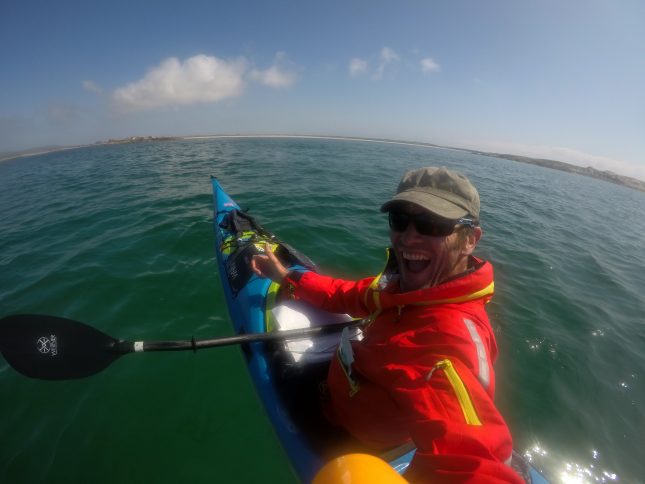
Early 2018 I contacted The National Trust for Scotland and request to camp on St Kilda over a week in early June. The Calmac ferry is booked from Uig to Lochmaddy. The commitment has begun.
My commitment to physical preparation was questionable. My training for St Kilda was non-existent. I do reckon that the Moriston Enduro Kayak event, two weeks before, where I did 10 reasonably intense but well-paced laps of the Upper Moriston in 3 hours helped and the variety of paddlesport courses that I had worked early season contributed. It was really after all going to be about the psychology wasn’t it?
May 2018
High pressure builds over the UK. Will it Stay? 1 week passes, a second week, a brief blip then rebuild, will it hold for a third? I commit. I go.
Saturday 2nd June Dropping in on ‘Whitewave’ on North Skye on Saturday night the wind is howling and the haar is in. There Anne Martin provides a delicious windy barbecued steak cooked out on their veranda as I listen to foghorns forlornly groan. So much for the high pressure. I remain committed.
Sunday 3rd June still in fog on the ferry, still the wind blows fresh from the North. I reach North Uist and have already decided to delay my departure. I relax.
With Hougharry as my departure point I decided to stay at the campsite where they are very accommodating. I let Ann the site manager know my intentions and she was happy for me to leave my vehicle there. The weather detail for the week showed a steady decrease in winds with Wednesday, Thursday and Friday looking exceptionally favourable. During the day I catch up with Russell Henderson, who was a client on a few sea kayak courses including a Greenland expedition. We sit and chat at the kitchen table at his mate’s, Andy McKinnon, watching a Hen Harrier float airily past. I talk about my plans. Always a good thing to do if you can.
My initial plan was to paddle via Haskeir and land a night there and return via the Monachs (also called Heskeir – different spelling). Russell helpfully suggests I go to the Monachs first. That plan appeared to be good and in fact better, as the landing on Haskeir is not guaranteed.
I returned to Hougharry for the evening. The bird song and bird activity a constant source of intrigue and pleasure. The drumming snipe all around and as always taking me back those many years to Loch Hourn
I take an evening walk from the campsite around the Aird an Runai, hoping to see St Kilda. It’s an amazing walk at this time of the year with abundant birdlife. I am pleased about my decision to wait. There’s still too much fog offshore and the winds continue fresh from the North – a better direction for the Monachs.
Monday 4th June. Dry, sunny, I relax, prepare and pack. Corncrakes fill the air with their rasps. They are virtually in your lap – so close yet so unseen. The white sand beach is metres from the campsite and with neap tides my midday departure is only a short carry. I finalise kit which includes 7 litres of water and 6 days food and fuel. The wind remains from the North so the Monachs it is. I call Stornoway Coastguard and inform them of my plans and send a final message to other shore contacts including my wife to keep them in the loop.
.
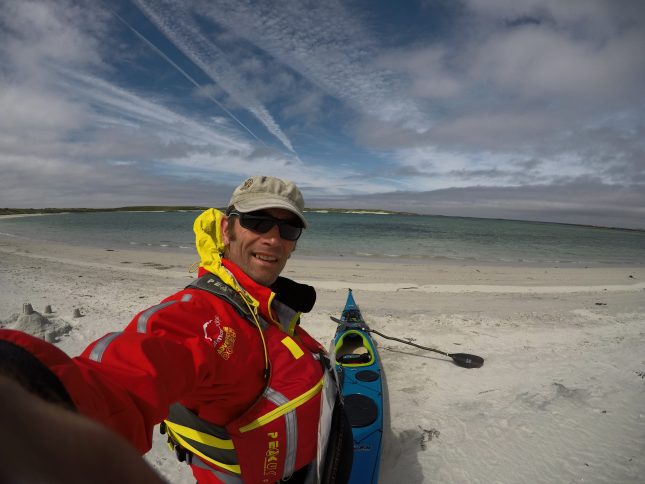
Leaving Hougharry
.
This is it, the start. Breathe. Pause. Go. Easy paddling out of the bay and a turn South. The Monach Island lighthouse providing the main focus, though I head for the east end of the archipelago. It is cruisy steady downwind paddling. A couple of hours later I land on the beach of Heamarabhagh on the easterly island Ceann Ear. A stretch of the legs and then on past the hundreds of ‘singing’ seals that currently reside. I land by the old jetty on Siolaigh and shuttle my kit and boat up above the high tide mark. There is great camping in the middle of the island shared with the numerous birds that make their presence known. Still St Kilda is shrouded by offshore cloud. The wind is still from the North but the forecast is consistently indicating east winds. I take a photo of a rusting wreck with the Lighthouse in the background, I decide to title the photo ‘Irony’. I am able to receive a text update from my wife of the most current wind both from XC Weather and Windfinder. A fishing boat anchors in the bay and I use it as my personal wind vane. I set my watch for 0400…
Tuesday 5th June 0400
0400. I get up. The wind vane has shifted more to the east. In the night I was aware of the reduced noise from swell on the rocks, not just because of high or low tide. The omens are good. Coffee, biscuits, banana and an apple. It’s all I can manage. I take a precautionary ‘Kwells’ and paste my face and hands with sun cream.
0550 I’m on the water and paddling away. I have mild trepidation, mild adrenaline. I am mentally prepared for a 12-hour paddle. I decide that I can always turn around if I don’t like it. It’s good as I have given myself permission. I know I won’t turn around though…an exhalation – I go.
The seas are lumpy, the wind Force 3 over my right shoulder. My Bearing is 305°.
I had quite a few questions that I couldn’t find the answers to. Mainly around managing yourself on a solo open crossing. There is very little literature out there about it and I am sure it is a very personal thing.
My initial routine was to paddle 2 hours and then have an untimed break. I managed to maintain this over the first six hours. After that the breaks came more frequently, I had begun to ‘clock watch’. They were not all breaks as such, just getting food on board, checking position, checking bearings, checking the distance covered, minor adjustments to sitting, a bit of go pro videoing and not quite enough drinking! I tried to space the later breaks an hour apart which on the whole I did.
My food was simple. Oatcakes, mars bars, flapjacks, peanuts, Zero tablets in a water bottle. For the final hour wine gums and jelly babies. The food was stored in small front knee hatch of my Cetus HV. My water was 500ml bottle with one zero tablet, drinking whenever I felt like it. I had 3 litres in an Ortleib bladder in my cockpit and could refill with that also adding a Zero tablet. I had read one account that advised not wearing water on/in your buoyancy aid, this adds weight to your torso rotation and also you cannot monitor how much you have had very easily. I drank less than 1 litre the entire crossing but did not feel dehydrated at the time having ‘loaded’ my body with fluids the day before and during the morning before departure.
Navigation. I had a moveable deck mounted compass quite close for ease of seeing the bearing. I also carried a hand-held compass in my knee hatch. I used ‘Viewranger’ on a smart phone turned to airplane mode. I had this on ‘Record a Track’. I had a Garmin 62s back up with spare batteries. Also carried in my buoyancy aid was a Spot Messenger location device. This was also programmed so I could send details of my location to key recipients aside from just an SOS so more functional than a pure Personal Locator Beacon. These three devices were all in waterproof cases. I had a watch on my buoyancy aid which I used to decide when to take breaks. My final bits of communication were a VHF Radio and in my day-hatch, some flares and a strobe.
Other safety equipment included a lifejacket, a paddle float, two spare airbags, a towline and a Peak UK Ocean Bothy cag, all accessible in my day-hatch. I did attach the paddle to the kayak with a piece of cord. I had a pump on deck behind me and a sponge in my cockpit.
Due to the forecast I opted to wear fleece trousers under my Peak UK Explorer Salopettes. I opted too for a double Peak UK Thermal Rashy Long and Short layer on my upper body worn under the Peak UK Adventure Double. This has a stow away hood which, due to the following seas and wind, I had up most of the time. I also wore a warm hat and had a peaked hat and sun glasses.
Experiences on the crossing varied. An hour in I had settled down and felt great, the wind was helpful despite the lively sea. Well into the second hour I began to find that it was awkward to focus, no land ahead in sight and a constantly moving foreground. I could never get a fixed focus point and this felt odd. I also wondered whether the Kwells were kicking in and if I was feeling the drowsiness side-effects. Only much later when sea-birds began to appear did I find this ‘weirdness’ went.
Taking a pee necessitated removing the front of the spray deck. I had already decided if conditions were too rough I’d just wet myself. I had been recommended a Uribag – thanks Angus Crozier – and had bought one. I’d never trialled it but found it great for the job. Small, compact and easily stowed. I put the skeg down to allow the boat to run downwind and offer greater stability then went about my business. Fortunately I only had one small wave come into my cockpit when my spraydeck was off and fly zip was open. I had also opted to wear just fleece trousers, nothing underneath, this made the going even easier. The Peak UK Explorer Salopette zip worked fantastically.
My hands are quite susceptible to getting cold kayaking so I always have pogies to hand even in mid-summer. These I kept on deck and did end up using them.
Entertainment – some folk like listening to music, I like to hear my environment so find other means to absorb time. At times I focussed on my paddling technique, just randomly talking to myself. I used alphabet name games. I sang quite badly. I listened to the coastguard forecasts a couple of times. I talked to any birds spotted and gave them character ‘voices’ sometimes using their scientific nomenclature: Sula Bassana’ (gannet) was Hispanic, Fulmars were the silently curious ones where I gave no language other than a long deep hello. Leach’s Petrels were squeaky skittery voiced, indecisive about what direction to head in; Razorbills were the moustached RAF wing commanders with ‘Jolly Ho’ expressions and Puffins were waiting to serve me in humble fashion. Guillemots were the bouncing bombs and the Great Skuas the bullies of the skies. Okay so a bit off the wall but entertaining and time absorbing.
As indicated navigating was pretty simple…follow the deck compass. Check Viewranger. Maintain my steady stroke rate. When the St Kilda archipelago came to view I aimed between the islands – a renewed bearing of 310 degrees seemed to work well.
Seeing St Kilda was motivating. This did happen well before half way but it was not always visible in the swell. Over half way in, my navigation system was also motivating. Knowing I had covered over 24 km in the first 4 hours and over 36 in 6hrs averaging over 6km/hr also spurred me on. Tuesday was also a staff changeover on St Kilda (as I later found out) and a number of helicopter flights over me helped distract and displace me from time. The approach of a boat heading in the same direction gave further distraction as it did when it turned around to spot dolphins, which I had also seen and again later on. I found out that they were a small pod of White Beaked dolphins. I was not ‘alone’ then. I did find this human presence slightly irksome as in some way I felt it devaluing the sense of commitment – help was close to hand should I have needed it. I guess the added benefit was it made me more determined not to need their help. I did also wonder though that if they spotted me would they come and check me out, I cannot imagine that the helicopter team did not see me as they passed pretty close by.
So onwards, Levenish came to view. The most eastward isle of the archipelago. Once I had finally reached Levenish I relaxed, slowed down and absorbed my experience. I had never been so pleased to see a lump of rock that I couldn’t land on. My landing was now only 4 km away. I devoured my wine gums and jelly babies, paying the price I believe next day with a sugar hangover, possibly also exacerbated due to dehydration.
The bird numbers had dramatically increased with the air full of them. Seal appeared and disappeared. The tidal stream appeared to sweep me northward requiring a quick correction. The sense of time now passed quickly.
.

.
1620 Arrival at the bustle of Village Bay. Three tour boats were on moorings and their flit boats were ferrying their passengers back after their visit. People, noise, activity. Landing. ‘Don’t mess this one up now Giles.’ I chose not to land by the jetty, too many boulders at that particular tide state, instead opting for the seaweed covered and slippery shelving slabs to the east. Patience, 9.5 hrs have passed so take your time. It went well after a couple of false starts. Timing the landing on a smaller wave set on my third attempt, I was surprisingly mobile when standing up. I was able to slide my heavy boat on the weed. No damage. Success. Relief. Relax. Pleasure. Smile a positively immense gurn. No welcoming committee, my moment to savour – no-one had any idea what I had just done. Solo.
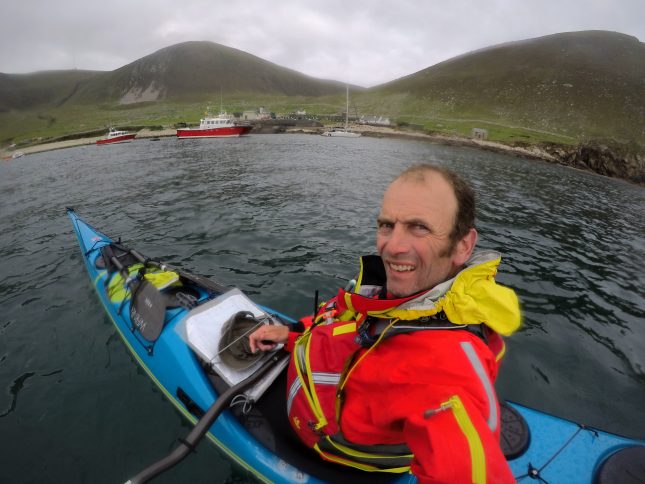
Arriving at Village Bay
.
Those of you that are familiar with sea kayak journeying will now recognise the must do routine after landing. Moving a laden boat on your own is not easy so using my Peak UK kit bags I ferried all my kit up to a flat grassy area. Then with the boat now empty I shouldered it up to join the rest of the kit.
.
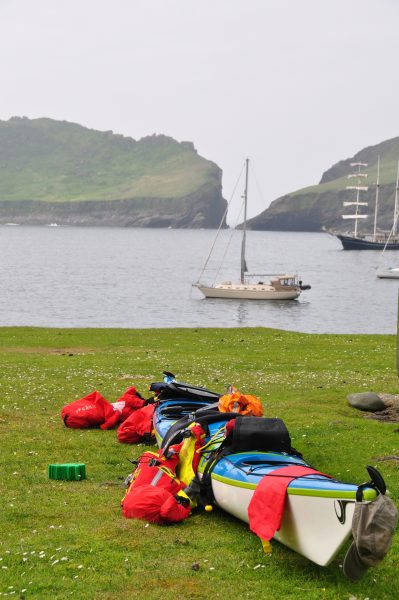
.
With phase one done it was then find the campsite and get the paddle clothing out to dry, tent sorted and organised and dinner on – or at least a cup of tea…then I could slow down. The main relief here was that the campsite was not far away and it was dry, warm and midge-less. Just what you want as opposed to what it often is in June on the West of Scotland.
The next 36 hours were an enjoyable pleasure. I had time to wander around the old village on the first evening, summit Conachair the next day, take photographs, write my diary, speak to fellow campers, a contract plumber who had been visiting St Kilda for a few years and other people visiting. I observed the St Kilda Wren and the St Kilda Mouse go about their business. I even got back in my boat and had an entertaining paddle around Dun. This included having a close encounter with a rather large basking shark, a rather large wave and speaking to some yacht-based climbers checking out a route. It was topped by paddling among thousands of puffins.
.
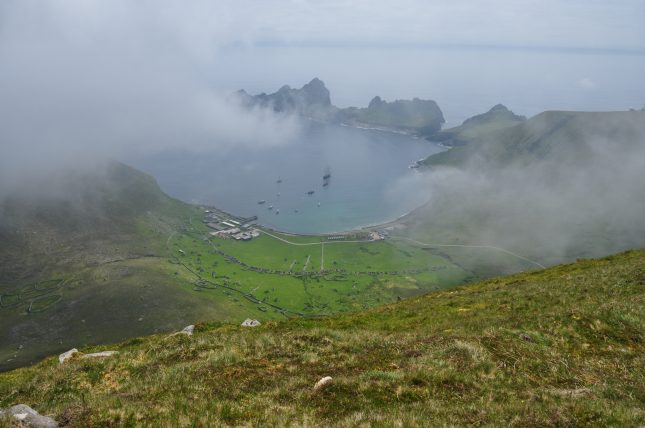
.
I met the warden – Peter Holden – who offered me the latest forecast and also asked if I had enough supplies. Seeing that helped me decide that on this occasion I would leave after one day. It would have been possible to stay and circumnavigate the other islands but I reckoned I would not enjoy it as much thinking that I should be paddling back – no need to push my luck, I will return.
Set then for the return journey. As so often I do with an early start planned I made sure everything was ready. With the tide state meaning a sandy launch site at the pier as opposed to the slippery slabs I landed on, I had my boat ready positioned close by. Crossing food was already organised and all that I had up at my tent were a few essentials for the morning. Alarm set for 0400.
Thursday 7th June
0400 beep, beep, beep, beep. Reactor on, coffee made, banana, biscuits, muesli, water consumed. Pop a Kwells to manage potential motion sickness. Sleeping bag pack, thermarest pack, tent pack – go.
0530 – depart Village Bay.
It was St Kilda quiet. No one to see me off. The steady thrum of the generator there to remind anyone of the radar station and its energy requirements. The visiting yachts gently rocking, still asleep at anchor. The birds, well awake but almost respectful of the hour and quietly noisy. No manic squawking.
Given the forecast I opted for a different clothing plan. It would be warm on the windless sea. I didn’t want to fully commit to a cag-less paddle and did not fancy messing around putting one on if conditions were lumpy so opted to wear one. Underneath though I had a thin The North Face long sleeved base layer. For my legs I also stuck with my Explorer Salopettes but this time I wore just a pair of running shorts and no socks. This option proved perfect. It was warm. One ‘fear’ I had was that in the ‘heat’ of all the exertion I wouldn’t drink or eat enough and I could end up having some physiological and psychological challenges. Fortunately, as I have had many long physical days in various conditions I know well how my body will respond and how to manage my physiological requirements. As a result I made sure I followed a much more robust hydration and nutrition routine than my paddle out to St Kilda. Suffice to say I peed a lot more.
.
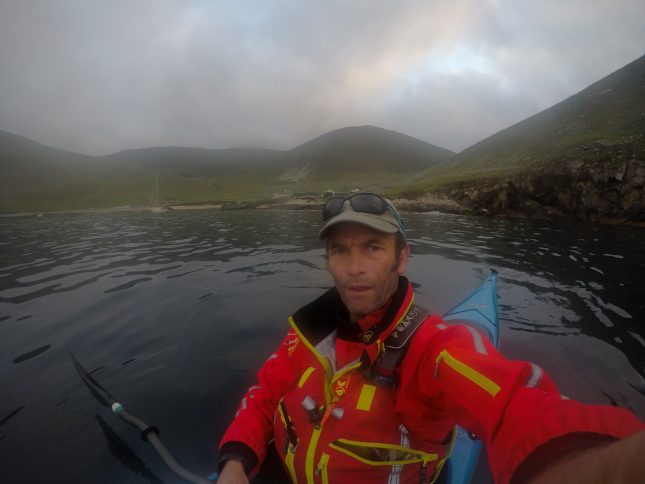
Departing Village Bay
.
And it was warm. To keep cool I frequently dipped my cap in the water as well as my hands. I made sure the cap was wet enough to cool me but not so wet as to dribble water down into my cag.
The sea’s surface was oily calm. A small multidirectional swell reminded me of where I was. The paddling though was easy fast. Had it been a focus it would have been a day for record setting. I set a medium fast cadence which I found easy to maintain. I planned a similar time routine to the paddle out. However a couple of hours in I ditched this as I realised I would need to drink more frequently and I had the perception that I was drifting northwards. On examination of my track this was the case and despite bearing adjustments I couldn’t quite find the right angle to maintain and every time I checked I had drifted further north.
Due to the haze I could not see any land ahead of me until over half-way. The compass became my constant companion again. The sun though weak through the haze, felt warm and bright, my polarizing glasses and peaked cap eased the strain, again essentials to manage any potential for mishap. Sun blindness would be a serious issue out here.
Marine life tracked me for many hours. Accompanying me away from St Kilda. I could clearly hear the wing beats of various birds as they flew by, especially the gannets with no uplifting winds. I was surprised by seal 30km from any land. Dolphins again appeared just once. I had my bird conversations over again and briefly played a game that a friend – Suresh Paul – had come up with on a British Canoeing 5 star sea kayak training course many years ago. When a seal appears you attempt to ‘blow’ it back under water. Weird maybe but it filled a minute or two. The seal appeared to have their own game. They would surface behind me with a clear blow of air and when I turned to look they would disappear with a great splash before I could actually see them.
Time ticked by.
I spotted the Heskeir Islands, a renewed focus, they were 16 km away. It remained oily calm, I didn’t quite relax at this stage but knew that on reaching them it was significant, I would succeed, even if the un-forecast wind appeared. I maintained the high cadence and possibly even increased it as my track log later indicated a speed increase. Despite not quite relaxing I was definitely anticipating success and by now smiling manically and occasionally chuckling. The sea maintained its status quo although the marine life had dramatically reduced with only the odd bird appearing and by now I had blown all the seals away. The Heskeirs, which, after some reading, I had named the land of a thousand fulmars – although inviting a landing, were not to receive one. I was only focussed now on reaching the main land of North Uist. I did pass between the main islands though and staged a long – boat bound – stop to video and onboard refuel before the final surge.
Time sped by now.
I began to feel like an airborne bird descending into landing. Effort over, I slowed down, into glide mode. Reduced thrust, autopilot off. Another great gurn, bigger this time than the one on arrival at St Kilda. Even better was that with the early start at 0530 the 10.5 hrs it took me meant I had arrived with plenty of day to spare. No champagne celebration but no let down either. The slow motion button was on.
The warm surge of success, enhanced by the fine warm weather, there can’t have been many crossings where people have arrived to such comfort. I was salt encrusted satisfied.
Ann appeared genuinely pleased and impressed to see me, took my photo and posted it on the campsite Facebook page. She provided some fresh milk for me too…it’s the little things as they say…
It proved to be another sublime evening of weather and I enjoyed it with more al fresco dining and the evening bird sounds all about accompanied of course by the ever-present snipe drumming. Be assured, when I did eventually hit the pillow it was as sound a sleep as any.
Part of these adventures should involve time to savour. Too many people these days have a tick list and move quickly on, squeezing great achievements into busy lives for sure, but perhaps missing a bigger picture…I was in little hurry and with another two nights at Hougharry with great weather forecast that was what I did and I was not disappointed. St Kilda had somehow given me a calmness that endured for quite a while…
.
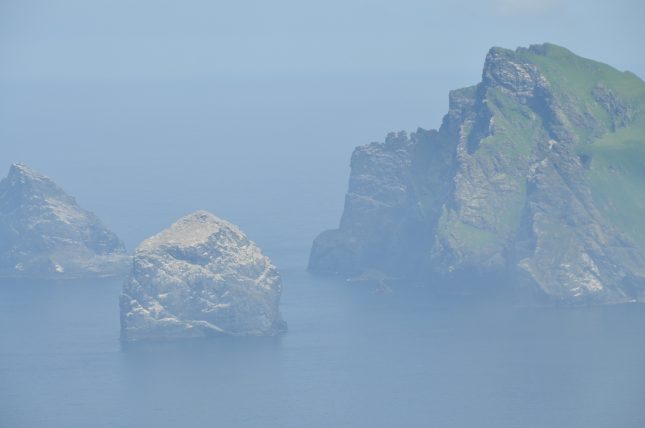
.
Throughout Summer 2021, Glenmore Lodge is running the following sea kayak expeditions:
North West Sea Kayak Expedition departing 5 July 2021
Mull Sea Kayak Expedition departing 2 August 2021
Raasay and Rona Sea Kayak Expedition departing 21 June 2021
Jura, Garvellach, Luing and Scarba Expedition departing 19 July 2021
Building up your confidence? We have a 5 day Learn Sea Kayaking course, which includes a multi day sea kayak journey.
About Giles Trussell
.

.
Fortunate to paddle from an early age and live close by the sea (50 metres from the high water mark) sealed Giles’s future love of sea kayaking. Spring tides were already understood at the age of 11 when he used look for – and find – lost fishing tackle on the shores of the Gareloch – low equinoxial spring tides being the best.
In 1996-97 he had a ‘transformational year’ while on a 13 month Atlantic Circuit in a 9 metre yacht, sailing with one other person.
A few years on and as well as a passion for all things canoe and kayak, sea kayaking exploits have taken him around many of Scotland’s Islands, often solo. He has enjoyed numerous sea kayak expeditions around the world including Southern Greenland, the Mediterranean and an epic circumnavigation of Stewart Island in New Zealand with a friend in 2010. That year only 3 people completed the circumnavigation.
In 2018 he realised a long term ambition to solo sea kayak to St Kilda…and back again.
Most recently in 2020, in between lockdowns, he had the fortune to enjoy a leisurely 9 day solo expedition around the Isle of Mull.
For sea kayaking – he says – “Scotland is as good as it gets anywhere in the world.”
Giles helps deliver the Glenmore Lodge paddlesports programme. For more details about sea kayak expeditions and skills courses, visit our website.